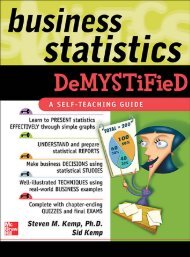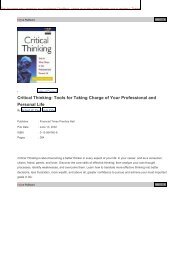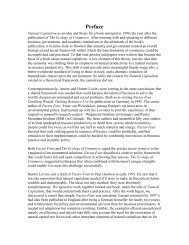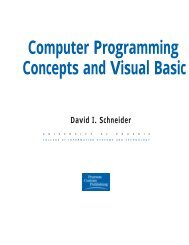Chapter 06 - Changing Education Paradigm
Chapter 06 - Changing Education Paradigm
Chapter 06 - Changing Education Paradigm
Create successful ePaper yourself
Turn your PDF publications into a flip-book with our unique Google optimized e-Paper software.
8 CHAPTER 6. MINING ASSOCIATION RULES IN LARGE DATABASES<br />
Scan D for<br />
count of each<br />
candidate<br />
,!<br />
Generate C2<br />
candidates from<br />
L1<br />
,!<br />
Generate C3<br />
candidates from<br />
L2<br />
,!<br />
C3<br />
C2<br />
Itemset<br />
fI1,I2g<br />
fI1,I3g<br />
fI1,I4g<br />
fI2,I3g<br />
fI2,I4g<br />
fI3,I4g<br />
Itemset<br />
fI2,I3,I4g<br />
C1<br />
Itemset Sup.<br />
fI1g 2<br />
fI2g 3<br />
fI3g 3<br />
fI4g 3<br />
fI5g 1<br />
Scan D for<br />
count of each<br />
candidate<br />
,!<br />
Scan D for<br />
count of<br />
each candidate<br />
,!<br />
C3<br />
Itemset Sup.<br />
fI2,I3,I4g 2<br />
Compare candidate<br />
support with<br />
minimum support<br />
count<br />
,!<br />
C2<br />
Itemset Sup.<br />
fI1,I2g 2<br />
fI1,I3g 1<br />
fI1,I4g 1<br />
fI2,I3g 2<br />
fI2,I4g 2<br />
fI3,I4g 3<br />
Compare candidate<br />
support with<br />
minimum support<br />
count<br />
,!<br />
Compare candidate<br />
support with<br />
minimum support<br />
count<br />
,!<br />
L1<br />
Itemset Sup.<br />
fI1g 2<br />
fI2g 3<br />
fI3g 3<br />
fI4g 3<br />
L2<br />
Itemset Sup.<br />
fI1,I2g 2<br />
fI2,I3g 2<br />
fI2,I4g 2<br />
fI3,I4g 3<br />
L3<br />
Itemset Sup.<br />
fI2,I3,I4g 2<br />
Figure 6.3: Generation of candidate itemsets and frequent itemsets, where the minimum support count is2.<br />
1. C3 = L2 1 L2 = ffI1,I2g, fI2,I3g, fI2,I4g, fI3,I4gg 1 ffI1,I2g, fI2,I3g, fI2,I4g, fI3,I4gg =<br />
ffI1;I2;I3g;fI1;I2;I4g;fI2;I3;I4gg.<br />
2. Apriori property: All subsets of a frequent itemset must also be frequent. Do any of the candidates have a<br />
subset that is not frequent?<br />
{ The 2-item subsets of fI1,I2,I3g are fI1,I2g, fI1,I3g, and fI2,I3g. fI1,I3g is not a member of L2, and so<br />
it is not frequent. Therefore, remove fI1,I2,I3g from C3.<br />
{ The 2-item subsets of fI1,I2,I4g are fI1,I2g, fI1,I4g, and fI2,I4g. fI1,I4g is not a member of L2, and so<br />
it is not frequent. Therefore, remove fI1,I2,I4g from C3.<br />
{ The 2-item subsets of fI2,I3,I4g are fI2,I3g, fI2,I4g, and fI3,I4g. All 2-item subsets of fI2,I3,I4g are<br />
members of L2. Therefore, keep fI2,I3,I4g in C3.<br />
3. Therefore, C3 = ffI2;I3;I4gg.<br />
Figure 6.4: Generation of candidate 3-itemsets, C3, from L2 using the Apriori property.










